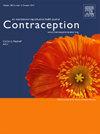DISTANCE TRAVELED TO OBTAIN ABORTION CARE IN SOUTHERN ILLINOIS BEFORE AND AFTER THE DOBBS V JACKSON WOMEN’S HEALTH ORGANIZATION DECISION
IF 2.8
2区 医学
Q1 OBSTETRICS & GYNECOLOGY
引用次数: 0
Abstract
Objectives
We aimed to examine changes in one-way driving distance for people seeking abortion care at a single site before and after the Dobbs v Jackson Women’s Health Organization decision, and to identify factors associated with traveling ≥250 miles.
Methods
We conducted a retrospective cohort study of abortions performed at a single abortion clinic in Southern Illinois for 12 months pre- and post-Dobbs using electronic scheduling data. We compared patient characteristics and one-way driving distance using chi-square. We used a multivariable logistic regression to identify factors associated with a one-way driving distance ≥250 miles.
Results
In total, 12,920 abortions occurred from June 2021 to June 2023: 4,666 pre-Dobbs and 8,254 post-Dobbs. The median one-way driving distance increased from 20 miles (IQR 14-118) to 142 miles (IQR 17-312) (p<0.001). Post-Dobbs, a smaller proportion of patients traveled <25 miles, while the absolute number remained stable: 2,617 (56.1%) vs. 2,891 (35.0%). Post-Dobbs, the number of patients traveling ≥250 miles increased by 701% (488 to 3,469). The proportion of out-of-state patients receiving abortions increased from 66.6% to 83.0% (p<0.001). Post-Dobbs, patients traveling≥250 miles for an abortion were more likely to be ≥12 weeks gestational duration (adjusted OR (aOR) 2.94, 95%CI 2.63-3.29), of Hispanic origin (aOR 2.78, 95%CI 2.20-3.51), and self-pay for their procedure (aOR 9.59, 95%CI 8.00-11.48).
Conclusions
Post-Dobbs, we observed a seven-fold increase in patients traveling≥250 miles for care at a single independent abortion clinic in Southern Illinois. These findings highlight the increased barriers to abortion access caused by restrictive legislation in the US.
多布斯诉杰克逊妇女健康组织案判决前后伊利诺伊州南部地区为获得堕胎护理所走的路程
我们旨在研究在多布斯诉杰克逊妇女健康组织案判决前后,在单个地点寻求人工流产护理的人的单程驾驶距离的变化,并确定与旅行≥250 英里相关的因素。方法 我们使用电子排班数据对南伊利诺伊州单个人工流产诊所在多布斯案前后 12 个月内进行的人工流产手术进行了回顾性队列研究。我们使用卡方检验比较了患者特征和单向行车距离。结果在 2021 年 6 月至 2023 年 6 月期间,共有 12920 例人工流产:多布斯之前 4666 例,多布斯之后 8254 例。单程驾驶距离的中位数从 20 英里(IQR 14-118)增加到 142 英里(IQR 17-312)(p<0.001)。多布斯手术后,行驶<25英里的患者比例降低,但绝对人数保持稳定:2617人(56.1%)对2891人(35.0%)。多布斯事件后,行程≥250 英里的患者人数增加了 701%(从 488 人增至 3469 人)。州外患者接受人工流产的比例从 66.6% 增加到 83.0% (p<0.001)。多布斯案后,妊娠期≥250 英里的流产患者更有可能妊娠期≥12 周(调整 OR (aOR) 2.94,95%CI 2.63-3.29)、西班牙裔(aOR 2.78,95%CI 2.20-3.51)和自费流产。结论在多布斯事件后,我们观察到在南伊利诺伊州的一家独立堕胎诊所就诊的患者中,旅行里程≥250 英里的患者增加了七倍。这些发现凸显了美国限制性立法对堕胎造成的更多障碍。
本文章由计算机程序翻译,如有差异,请以英文原文为准。
求助全文
约1分钟内获得全文
求助全文
来源期刊

Contraception
医学-妇产科学
CiteScore
4.70
自引率
17.20%
发文量
211
审稿时长
69 days
期刊介绍:
Contraception has an open access mirror journal Contraception: X, sharing the same aims and scope, editorial team, submission system and rigorous peer review.
The journal Contraception wishes to advance reproductive health through the rapid publication of the best and most interesting new scholarship regarding contraception and related fields such as abortion. The journal welcomes manuscripts from investigators working in the laboratory, clinical and social sciences, as well as public health and health professions education.
 求助内容:
求助内容: 应助结果提醒方式:
应助结果提醒方式:


